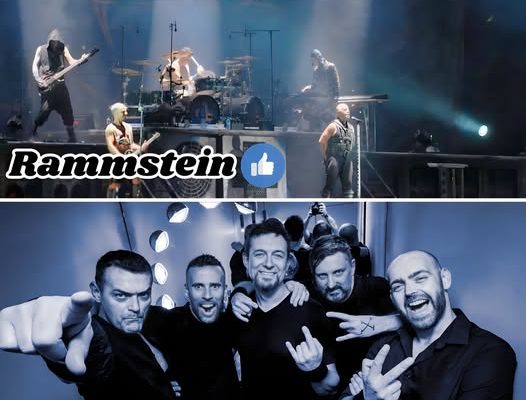When two worlds of uncompromising sonic aggression collide, the result is nothing short of seismic. “Grand Sound Clash: Rammstein’s Monumental Industrial Metal Meets Pitchshifter’s Bold Fusion of Electronic, Nu-Metal, and Experimental Power” is more than a comparison—it’s a collision of philosophies, sound design, and artistic rebellion. On one side stands Rammstein, the titans of German industrial metal whose explosive combination of heavy riffing, mechanical rhythm, and theatrical spectacle has redefined modern metal. On the other, Pitchshifter, the British innovators who fearlessly fused metal, punk, electronic, and drum-and-bass elements long before hybrid genres became mainstream. Both bands emerged from different backgrounds, yet their purpose has always been aligned: to challenge the boundaries of sound, confront conformity, and push music into uncharted territory.
Rammstein’s story begins in the post-reunification landscape of 1990s Germany, a time when art and politics collided in every sense. Their sound was born out of the raw industrial spirit of East Berlin—cold, mechanical, and militant, but also poetic and provocative. From their 1995 debut Herzeleid to later albums like Mutter, Reise, Reise, and Zeit, Rammstein have constructed an empire of sound that feels both ancient and futuristic. Their riffs grind like factory machines, their lyrics drip with dark romanticism, and their performances ignite literal flames of rebellion. Every concert is an act of theater, every lyric a weaponized metaphor. Till Lindemann’s deep, authoritarian voice commands not just a crowd but a cultural movement—one that thrives on the forbidden and the primal.
Across the channel, Pitchshifter emerged from Nottingham’s underground in the late 1980s, at a time when industrial music was still an obscure, abrasive form reserved for the fearless. Founded by brothers JS and Mark Clayden, Pitchshifter began as a hard-edged industrial act with influences like Godflesh and Ministry, layering grinding guitars with samples and distorted vocals. But the band didn’t stay confined for long. By the mid-1990s, they had evolved into a hybrid monster that fused drum-and-bass, breakbeats, punk, and nu-metal energy. Albums like www.pitchshifter.com and Deviant demonstrated a fearless embrace of electronic modernity while retaining a furious social edge. Their lyrics often challenged government control, technological dependence, and media manipulation—a rebellion as intellectual as it was visceral.
The clash between Rammstein and Pitchshifter is fascinating because it’s not merely about genre—it’s about ideology. Both bands use industrial textures as tools of defiance, but they wield them differently. Rammstein uses repetition and precision as an expression of discipline and dominance; every beat and flame feels calculated, every riff a symbol of control. Pitchshifter, on the other hand, thrives in chaos—their sound feels improvised, disruptive, even anarchic. If Rammstein is the metallic heartbeat of a dystopian regime, Pitchshifter is the cyberpunk uprising tearing that regime down from within. Together, they form two sides of the same coin: order and rebellion, structure and disarray, the authoritarian and the anti-authoritarian.
In terms of sonic architecture, Rammstein’s approach to industrial metal is monumentally cinematic. Their songs are constructed like vast machines, with each component polished to perfection. Christoph Schneider’s drumming is not just rhythm—it’s machinery in motion. Paul Landers and Richard Kruspe’s guitars act as pistons, firing in sync with the relentless mechanical tempo. Flake Lorenz’s keyboards add eerie synthetic textures that evoke both human emotion and mechanical coldness. And over it all, Till Lindemann’s voice looms like a demonic conductor, alternating between guttural growls and operatic declarations. The German language becomes an instrument itself—percussive, powerful, and hypnotic. It’s music designed not merely to be heard but to be felt deep in the gut, like standing inside a working engine.
Pitchshifter, by contrast, often approached the same mechanical intensity from a digital direction. Their use of electronic programming, sampled beats, and processed basslines gave their music a sense of futuristic volatility. Songs like “Genius,” “Microwaved,” and “Please Sir” capture a distinctly British brand of rebellion—sarcastic, cynical, and self-aware. Instead of grand spectacle, Pitchshifter relied on confrontation and experimentation. Their sound, especially during their late-90s peak, was a chaotic conversation between technology and humanity. JS Clayden’s vocals were filtered, distorted, and fragmented, embodying the alienation of the digital age. Where Rammstein’s flames illuminate ancient fears and forbidden desires, Pitchshifter’s electronic edge reflects the anxiety of modern existence—the paranoia of surveillance, the suffocation of conformity, and the dehumanization of life in a networked world.
Culturally, both bands served as outsiders who found their way into the mainstream without compromising their essence. Rammstein, despite their controversial image and unapologetic use of provocative themes, became global icons. Their use of militaristic imagery, sexuality, and taboo subjects often stirred debate, but it was precisely this willingness to provoke that made them timeless. They transformed shock into art and controversy into commentary. Songs like “Ich Will,” “Mein Teil,” and “Deutschland” demonstrate their mastery of contradiction—how to critique and celebrate a culture simultaneously. Pitchshifter, while never achieving the same arena-filling status, carried a similarly defiant attitude. Their performances were raw, their politics sharp, their humor biting. They mocked authority while dissecting the absurdity of the digital revolution, long before social media turned rebellion into a brand.
In a live setting, Rammstein’s dominance is legendary. Their concerts are grand theatrical rituals—metal operas of fire, pain, and passion. Every song becomes a performance art piece, from Lindemann’s flamethrower antics to their use of pyrotechnics, choreography, and costume design. The experience is immersive, ritualistic, and at times overwhelming, as though the band commands both the stage and the collective psyche of their audience. Pitchshifter’s live energy, though less visually explosive, was no less intense. Their shows were a wall of sound and strobe lights, a fusion of punk urgency and digital distortion. The band’s interaction with fans was direct and confrontational—more about connection than control, more about chaos than choreography. Both acts achieved the same end by opposite means: total immersion in sound.
Thematically, the two bands’ lyrical universes also contrast sharply. Rammstein’s lyrics often dive into myth, desire, violence, and forbidden love, written with poetic ambiguity and layered symbolism. Their storytelling feels ancient, even when dealing with modern themes. Lindemann’s fascination with human darkness turns songs into gothic tales—twisted yet strangely empathetic. Pitchshifter’s lyrics, on the other hand, are grounded in the now. They speak to disillusionment with technology, politics, and consumerism. “W.Y.S.I.W.Y.G.” (What You See Is What You Get) captures the cynicism of the digital era—how authenticity is replaced by presentation, and rebellion by branding. Both lyrical worlds intersect at a crucial point: the struggle for individuality in a dehumanizing system. Whether through the metaphor of myth or the realism of technology, both bands expose the cost of conformity and the hunger for identity.



